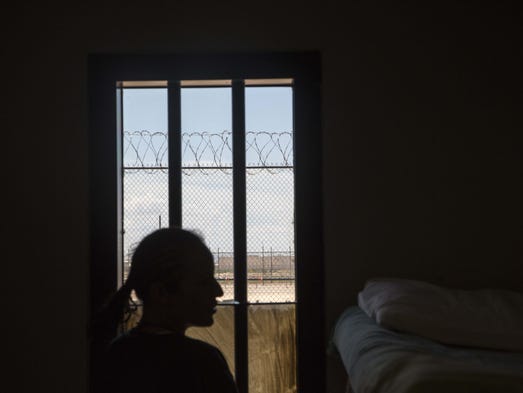
A woman in her room at the Eloy Detention Center
On Monday, November 28, U.S. Immigration and Customs, aptly named ICE, reported the death of Raquel Calderon de Hildago, a 36-year-old woman from Guatemala who had been a `guest’ of Eloy Detention Center. Located in Florence, Arizona, Eloy Detention Center is run by the inaptly named CoreCivic, formerly known as Corrections Corporation of America. In 2013, women prisoners in Eloy Detention Center went on hunger strike to protest life threatening conditions there. What has changed since then? Raquel Calderon de Hildago was the fifteenth person to die in Eloy, which makes Eloy the most fatal immigrant detention center in the United States. According to ICE, “Calderon is the third individual to pass away in ICE custody in fiscal year 2017.” Fiscal year 2017 began October 1, and already three people have died in ICE prisons. Raquel Calderon de Hildago did not pass away. She died in agony, after multiple seizures. She did not die. She was killed.
Carlos Garcia, executive director of Puente Arizona, noted, “For us it’s disappointing because this death, like the others, could have been prevented. But unfortunately this administration and (the prison operator) are not held accountable and so we see again someone’s life being lost.” The tragedy here is that there is no tragedy. There can’t be when each death at Eloy is just “another death at Eloy,” just another number in the fiscal year accounts. Raquel Calderon de Hidalgo’s life was not lost. It was thrown into the garbage dump of history. End of story.
Days before Raquel Calderon de Hildago died, a report on ICE’s immigration detention centers opened, “The U.S. government still fails to enforce basic standards of care at its privately and publicly contracted detention facilities, according to the National Immigrant Justice Center’s (NIJC) review of immigration detention facility inspections from 2013-2016 which were recently publicly released by U.S. Immigration and Customs Enforcement (ICE). ICE inspections data for the past five years indicate that many facilities have pending inspection ratings, in some cases for as long as two years,1 raising uncertainty about ICE’s adherence to a 2009 congressional mandate to close substandard facilities.2 As a result, inhumane conditions, including egregious violations of medical care standards, prevail across an immigration detention system composed of more than 200 detention facilities that detain approximately 34,000 immigrants daily.”
The report describes Eloy Detention Center: “Since 2003, 14 people have died at Eloy, operated by the Corrections Corporation of America (CCA). Office of Detention Oversight death reviews show significant lapses in medical care, including failure to respond promptly to medical emergencies, refer individuals to hospitals or other outside medical care, and address known flaws in facility operations that have led to the deaths of individuals in custody. ICE has not publicly released any inspection results for this detention center since 2012, and the facility’s Enforcement and Removal Office rating has been pending for two consecutive years.”
This report followed two other major reports, in February and July, respectively, that documented not only the terrible conditions in which people have been dying in immigration detention, but, equally, the fatal neglect on the part of all who run the prisons that condemns people to slow, painful and certain death sentences. From February to today, the only thing that has changed is that CCA became CoreCivic and that 14 is now 15. Raquel Calderon de Hidalgo’s death was a death foretold, as was the manner of her death.
According health law expert Stacy A. Tovino, “Many immigration detainees are physically and emotionally vulnerable at the time of initial confinement due to a history of torture and trauma, which may include human trafficking, sexual violence, political oppression, psychosocial trauma, and acculturative stress. Detention can exacerbate preexisting vulnerabilities and contribute to severe physical and mental illness as well as death. Between October 2003 and October 2015, 153 individuals died while in ICE custody.” The general situation is bad, and Eloy’s is worse. Eloy has consistently “refused to conduct” an examination or “ignored the call” by desperate detainee after desperate detainee. For example, Jose Lopez-Gregorio’s sick calls were ignored for seven days. Jose Lopez-Gregorio died hanging at the end of a bedsheet, but it wasn’t suicide. Like Raquel Calderon de Hildago, he was killed.
According to ICE, “At the time of her death, Calderon was awaiting removal to Guatemala. Database checks indicate she had no criminal history in the U.S.” Raquel Calderon de Hildago had no criminal history. Why did we sentence her to die; why did we kill Raquel Calderon de Hildago?
(Photo Credit 1: Nick Oza / Arizona Republic) (Photo Credit 2: NACLA)